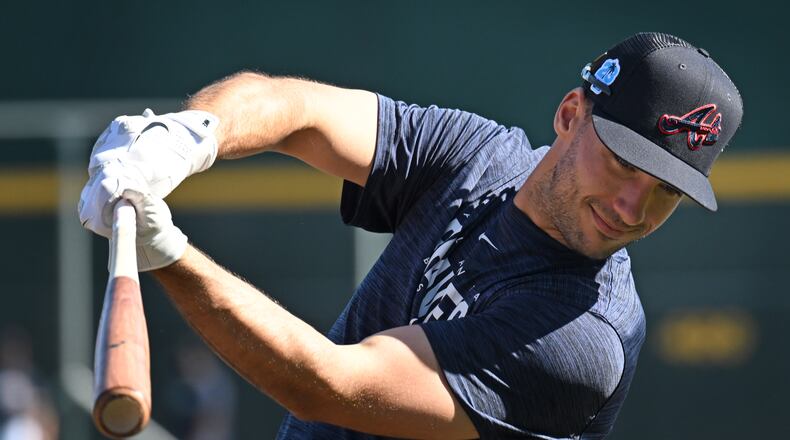FORT MYERS, Fla. — So, does the baseball look like a beach ball this spring?
Matt Olson smiled.
“I mean, it’s always good to come out and see some success early,” Olson said. “But, really, whether it’s going good or bad, it’s just the process of spring. Trying to see different pitches, get some at-bats under your belt and try to get some rhythm at the plate. It’s good when success is happening. But there’s a lot of factors. Some wind-blowing-out days. You’re seeing some different guys, too. They’re out there working on stuff, too, might not be the sharpest as well. Good to have the success, but (it’s) really just about the spring training process.”
This is, as Olson said, spring training. The wind can be generous on fly balls. Big-league hitters also face tons of minor-league pitchers who are not as talented as the arms they’ll see during the season. Plus, the big-league pitchers they do see now might simply be honing new pitches or adjusting to mechanical changes.
In some cases, spring training numbers cannot be taken at face value because context is needed.
Then again, Olson leads the Braves with five home runs in 28 at-bats this spring. He has a ridiculous 1.520 OPS in this miniature sample size. He’s hitting .429 and slugging 1.036. He has two doubles and 11 RBIs.
These numbers might be somewhat meaningful in that Olson, unlike last year, was able to settle into this spring. No trade speculation. No trade. No quick move after the trade. Less attention. For Olson, this spring has strictly been about baseball.
It’s nice that his numbers look great, but more than anything, he’s focused on his spring training process.
Olson, who turns 29 on March 29, is entering his sixth season as a full-time major leaguer. But he debuted in 2016. He’s been a part of many spring camps to this point and has adjusted his process accordingly.
Olson said there are two ways his process is much different now than when he was younger:
- “Well, personally, I like to get as many at-bats as possible. When I first started being a starter, and (was) kind of on that one (game) on, one (game) off deal, I would not get at-bats that second day, especially early on. I’ve learned I like to get more at-bats on those days that I’m off, whether it’s a live, or, going hitting (off the) machine for a little bit, kind of simulate it just to speed up the process.”
- “I think, early on, I also took it as trying to see pitches thinking it would help me get in a rhythm. What I’ve found is that I’m better when I show up and treat it like a real at-bat. There was times where I’d be like, ‘All right, I’m taking the first pitch of every at-bat today to try to get going’ and find myself in bad counts and feel bad after. It’s like, ‘Well, I put myself in a hole.’ Even though it’s early on, we’re just starting out, you got to treat an at-bat like an at-bat. I found that helpful. "
The second one – not taking pitches so you see more of them – is important, Olson said, because “I don’t do that during the season.”
“You got to be on every pitch. These guys are pretty good, so you can’t really give them any,” he said. “I think when I was younger, I kind of thought that’s what the older guys did. (They) came in, they had the jobs, so they had the luxury to see some pitches and kind of work counts. But for me, personally, that’s just not the way I like to approach it.”
Well, Olson is correct to continue trusting his process because it’s working. Since debuting, he has an .846 OPS over 2,664 at-bats. Last season, when he struggled toward the end, he still tied for second in the National League and third in the sport with 78 extra-base hits while driving in 103 runs.
During his work in the batting cage and in batting practice this spring, Olson has emphasized staying toward the middle of the field. “When I have the emphasis on that big part of the field, I’m able to have the space and the swing to just react,” he said. The approach is one thing. The swing is another. The first cannot be executed without the second.
In a recent spring at-bat, Olson hit a line drive to the third baseman. During that at-bat, he tried to be on the off-speed stuff more, so when the pitcher threw a fastball, he was late to it. But he was still on it and hit it hard.
“That feeling is the feeling that I look for,” Olson said. “When you’re not on time and (are still) able to get the barrel on it is normally one of the best signs as a hitter.”
So, no, Olson’s spring stats may not foreshadow a monster season. But it’s certainly a positive that he feels encouraged by his swing, which is something that will affect his regular-season outcomes.
Olson is one of the best first basemen in baseball. This spring, he’s been able to get his work in at CoolToday Park without the extra distractions he experienced after the trade last year.
We talk about Ronald Acuña Jr. and Austin Riley as having MVP potential. But you might be able to add Olson to that group.
“Yeah, I think he’s definitely capable of that, absolutely,” manager Brian Snitker said. “Absolutely. I mean, he can turn the game around in different ways.”
Can he win that award someday?
“I think every player has to step out on that field and have that confidence,” Olson said. “I’ve never been too bogged down in chasing that kind of stuff. It would be great. I think I’m very much capable of it. But I am more of the (mindset of) let the cards fall and go one game at a time and see where we’re at at the end. "
About the Author
Keep Reading
The Latest
Featured


